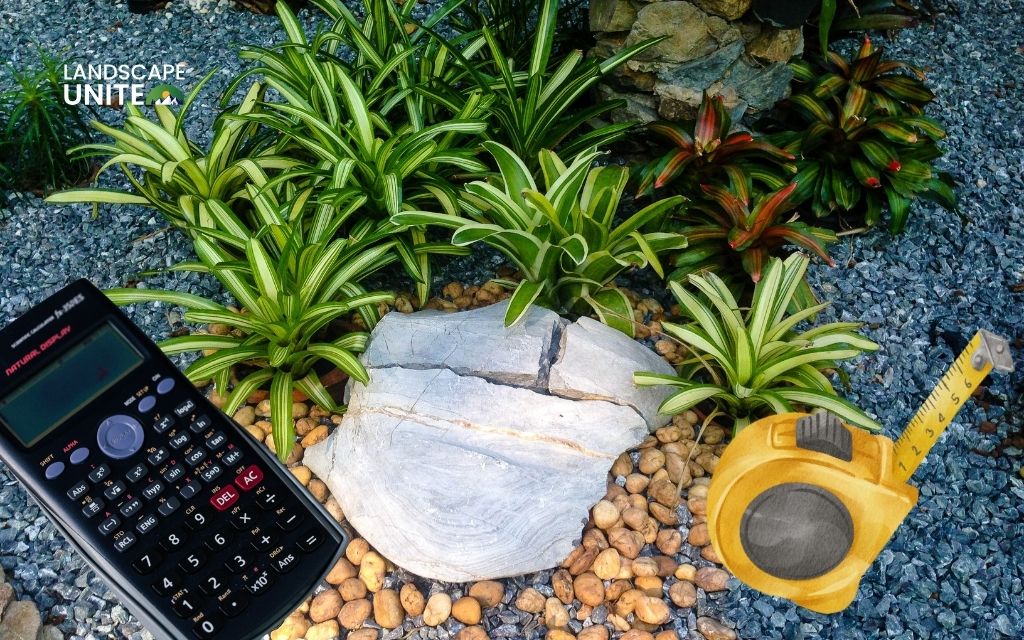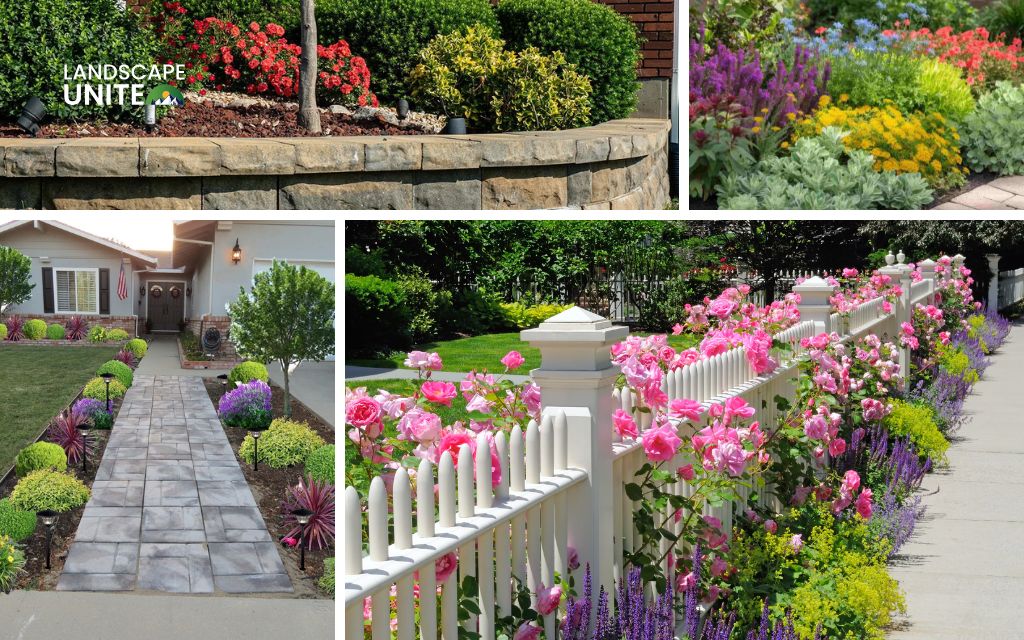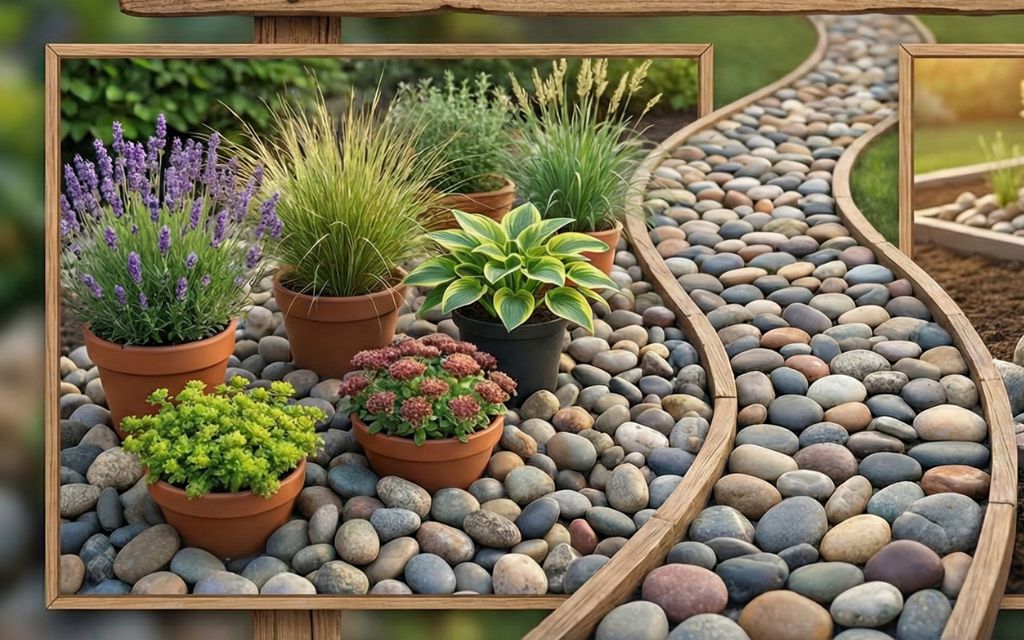The challenge with keeping squirrels out of garden spaces isn’t just their persistence – it’s their intelligence. Squirrels learn, adapt, and problem-solve with remarkable efficiency. What works today might not work next week if you don’t approach squirrel control strategically.
But, you don’t need to wage war on wildlife to protect your garden. This comprehensive guide will show you how to keep squirrels out of your garden using humane, effective methods that respect both your hard work and local ecosystem.
Let’s dive into understanding what draws these clever creatures to your garden in the first place.
What attracts squirrels to your garden
Understanding why squirrels target your garden is the first step toward effective protection.
Food sources are the primary attraction
Squirrels are opportunistic omnivores with a particular fondness for high-energy foods.
Freshly planted bulbs, especially tulips and crocus, are irresistible because they provide concentrated nutrition. Ripening fruits, tender vegetables, and seeds are equally appealing.
Even your bird feeders contribute to the problem, as spilled seed creates an easy meal that trains squirrels to visit your yard regularly.
Shelter and nesting
Shelter and nesting opportunities make your property even more attractive. Mature trees with cavities, dense shrubs, and even the spaces beneath raised garden beds provide perfect denning sites. If your property offers both food and shelter, squirrels will establish territories and return repeatedly throughout the season.
Water sources
Birdbaths, decorative fountains, drip irrigation systems, and even consistently moist soil near planters give squirrels convenient hydration. In dry climates or during summer months, water access can be just as important as food in determining where squirrels spend their time.
Garden structure
Raised beds, while excellent for growing, create protected spaces where squirrels feel safe while foraging. Mulched areas are easy to dig in, and loose, freshly worked soil practically invites excavation.
The very features that make your garden productive and beautiful can inadvertently make it more vulnerable to squirrel damage.
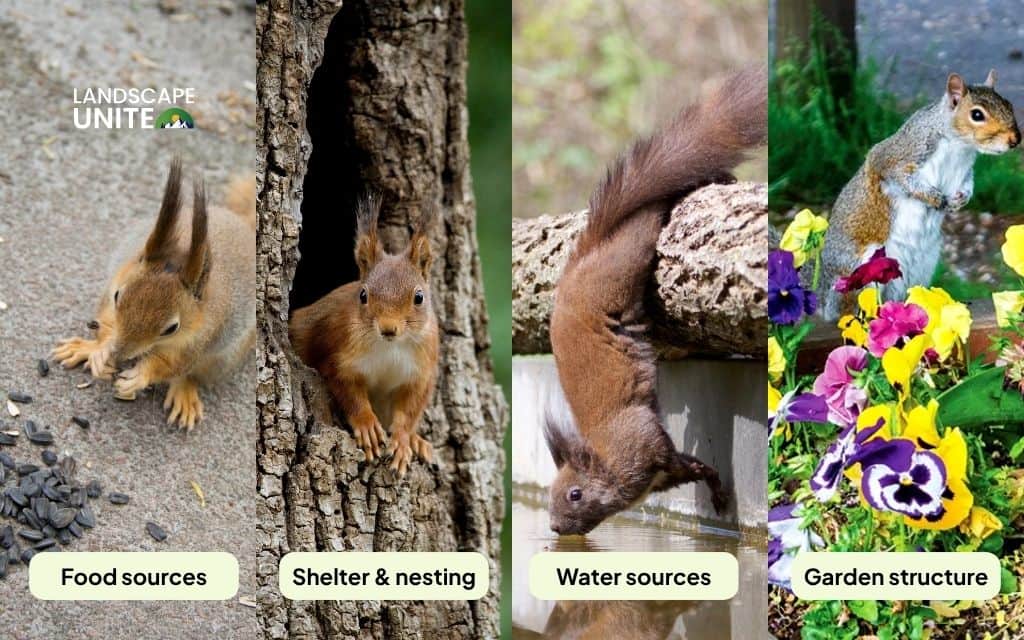
Common signs of squirrel damage
Recognizing squirrel damage early allows you to implement protective measures before significant destruction occurs.
Here are the telltale signs to watch for:
- Half-eaten fruits and vegetables: Tomatoes, strawberries, and produce with just a few bites taken, then abandoned
- Uprooted bulbs and scattered soil: Freshly dug holes in flower beds with bulbs pulled to the surface or partially eaten
- Missing seedlings: Young bean, pea, and sunflower plants pulled up entirely to access nutritious seeds
- Excavation holes in pots and planters: Deep holes that disturb roots and scatter soil around container edges
- Gnaw marks and stripped bark: Patches of missing bark on young trees, shrubs, and chewed plant stems
- Disturbed mulch and digging patterns: Random holes throughout garden beds where squirrels bury or search for food caches
- Squirrel droppings and tracks: Small pellet-shaped droppings and five-toed prints in soft soil or mulch
If you notice any combination of these signs, it’s time to implement protective measures immediately before damage escalates.
9 Proven methods to keep squirrels out of the garden
Successfully protecting your garden requires a multi-layered approach. Squirrels adapt quickly to single deterrents, so combining several methods creates the most effective defense.
Here are 9 strategies for how to keep squirrels out of your flower beds and vegetable gardens.
Use physical barriers and netting
Physical barriers remain the most reliable long-term solution for garden protection from squirrels.
Hardware cloth
Hardware cloth with quarter-inch openings creates an impenetrable barrier around raised beds or individual plants.
For squirrel proof raised garden beds, attach hardware cloth to the bed’s exterior, extending at least 2 feet above the soil line.
Bury fencing at least 6 inches deep around garden perimeters, bending the buried portion outward at a 90-degree angle to prevent tunneling underneath.
Chicken wire and row covers
Chicken wire and row covers offer lighter alternatives. Lay chicken wire directly over planted bulbs before covering with soil – bulbs will grow through the openings while squirrels can’t dig through.
Floating row covers protect vulnerable seedlings and young vegetables and still allow sunlight, air, and water to reach plants. Ensure all fencing is at least 24 inches tall for maximum effectiveness.
Apply natural squirrel repellents
Natural repellents make your garden temporarily unpleasant without causing harm.
DIY cayenne pepper spray
The formula: 1 tablespoon cayenne pepper plus 1 tablespoon dish soap in 1 gallon of water is the gold standard for vegetable garden protection.
Spray on soil surfaces, plant stems, and leaf undersides. Reapply every 3-5 days and after rain.
Commercial repellents
Commercial repellents like I Must Garden Squirrel Repellent or Bonide Repels-All use natural ingredients including dried blood, egg solids, and essential oils that trigger predator-avoidance instincts.
These concentrated formulas typically last 2-3 weeks. Focus applications on garden borders, soil surfaces where squirrels dig, and container rims for best results.
Use scent-based deterrents squirrels hate
Scent deterrents exploit squirrels’ sensitive noses.
- Coffee grounds sprinkled around flower beds discourage digging while adding nitrogen to soil – refresh weekly.
- Garlic powder dusted around plant bases creates an intense barrier, or makes a spray by steeping crushed garlic in water overnight.
- Blood meal triggers predator-avoidance responses while fertilizing plants.
- Peppermint oil on cotton balls near plants or in a spray (10-15 drops per cup of water) provides strong deterrence for containers and smaller spaces.
Rotate between different scent deterrents weekly and refresh immediately after rain to prevent squirrel acclimation.
Plant squirrel-resistant flowers and herbs
Strategic planting transforms your garden into a naturally less appealing target.
- Alliums (ornamental onions, garlic, chives), lavender, and mint contain strong scents that confuse and repel squirrels. Plant these as borders around vulnerable vegetables or flower beds.
- Daffodils, hyacinths, snowdrops, and fritillarias contain toxic alkaloids that squirrels instinctively avoid. Create defensive rings of daffodils around desirable tulip bulbs.
- Geraniums and marigolds have textured or sticky foliage that deters browsing.
Use companion planting strategically – interplant resistant species among vulnerable plants rather than grouping them separately.
Protect bulbs and planters
Line bulb holes with hardware cloth before planting, creating a cage that allows roots to penetrate while preventing squirrel access. After planting, cover areas with chicken wire secured flat against soil. Plants will grow through the mesh but squirrels can’t dig through it.
For containers, place decorative stones or cut wire mesh to fit pot tops, with holes for plants to grow through. This prevents the characteristic excavation damage.
When designing new beds, choose squirrel-resistant varieties like daffodils and alliums for the majority of plantings, using preferred varieties like tulips sparingly in protected areas.
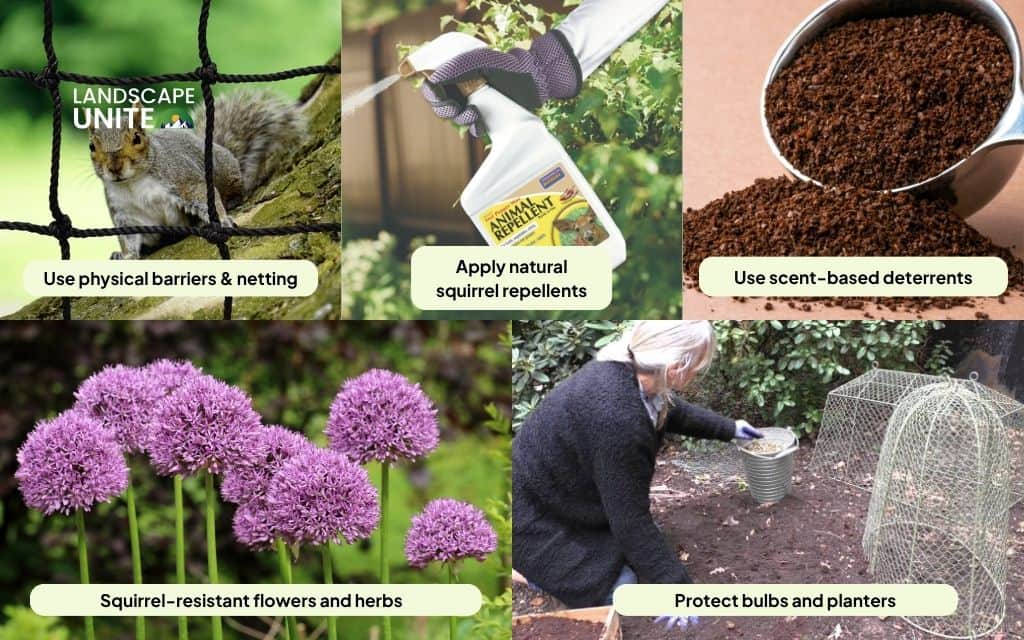
Try motion-activated sprinklers or noise devices
Motion-activated sprinklers like Orbit Yard Enforcer and Havahart Spray Away use infrared sensors to detect movement and release water bursts that startle squirrels.
Position units to cover entry points – fence lines, overhanging branches, and gaps between structures. Change positions every 2-3 weeks to prevent squirrels from learning patterns.
Ultrasonic repellers emit high-frequency sounds that irritate squirrels while remaining inaudible to humans. These work best in smaller, enclosed garden spaces combined with other methods.
Motion-activated devices require regular battery changes or power sources and work best as part of a comprehensive strategy rather than standalone solutions.
Manage food and shelter sources
Eliminate attractions by collecting fallen fruits, nuts, and birdseed daily during the growing season.
- Use squirrel-proof bird feeders with weight-triggered mechanisms, or eliminate feeders entirely during peak gardening months. Position any feeders at least 10 feet from trees and structures on smooth metal poles with baffles.
- Prune overhanging branches to maintain 8-10 feet of clearance from structures and garden spaces, forcing squirrels to approach from ground level where they’re more cautious.
Seal gaps in sheds, garages, and attics or any openings as small as 2 inches that allow squirrel access. Install quarter-inch mesh barriers beneath decks and raised beds to eliminate denning sites.
Create a squirrel diversion zone
Establish a feeding station at the farthest corner of your property, at least 50 feet from your garden if space allows. Offer whole corn, raw peanuts in shells, or sunflower seeds or any foods squirrels prefer over garden vegetables. Position near natural cover where squirrels feel secure.
This strategy works best combined with barriers and repellents in primary growing areas, redirecting rather than eliminating pressure. Monitor results as you may inadvertently attract additional squirrels in high-population areas.
Use pets or motion as natural deterrents
Dogs provide highly effective natural deterrence through scent and movement.
Allow regular yard access during peak squirrel activity (early morning and late afternoon). Even small dogs can be effective. Create designated patrol paths to prevent plant damage while maintaining protective presence.
Predator decoys like realistic owl or hawk statues can deter squirrels initially, but effectiveness requires movement.
Reposition decoys every 2-3 days, choose models with wind-activated moving parts, and vary decoy types between owls, hawks, and snakes. Your regular human presence also establishes territory.
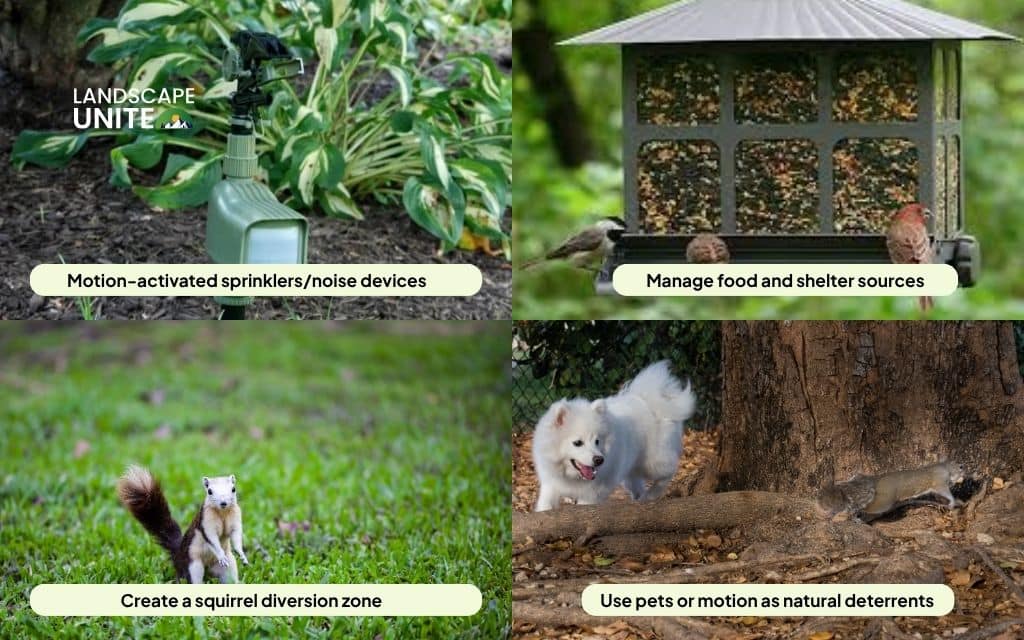
How to keep squirrels out of the vegetable garden
Vegetable gardens require special protection strategies that maintain food safety while deterring squirrels effectively.
- Install protective fencing around your vegetable garden using hardware cloth or welded wire with 1-inch openings. The fence should stand at least 3 feet tall with 6 inches buried underground and bent outward to prevent digging
- Use row covers and netting: Secure floating row covers over lettuce, spinach, and greens with landscape staples. Drape bird netting over tomato cages, berry bushes, and corn stalks as fruits ripen, ensuring it extends to ground level with no gaps. Check daily for tangled wildlife and adjust as plants grow
- Apply repellents strategically by spraying cayenne pepper solution on soil around plants and on stems and foliage. Avoid direct application on fruits you’ll harvest soon.Always rinse vegetables thoroughly before eating. For leafy greens and herbs eaten raw, apply repellents only to surrounding soil, not the plants themselves
- Harvest at optimal timing to minimize losses. Monitor vegetables closely as they ripen – squirrels often strike within 24 hours of peak ripeness
- Protect root crops by covering soil with hardware cloth after planting carrots, beets, and potatoes. The mesh prevents excavation while allowing shoots to emerge
- Use companion planting by interplanting vegetables with strongly scented herbs such as basil near tomatoes, mint along bed edges, garlic throughout. These aromatic plants help mask vegetable scents while diversifying your harvest
How to prevent squirrels from eating plants
Protecting ornamental plants and landscape features requires focused strategies for long-term plant health and aesthetic preservation.
- Apply foliar deterrent sprays using commercial hot pepper wax or bitter apple spray directly on ornamental foliage. Test on a few leaves first to ensure plant compatibility. Reapply every 7-10 days and after rain. These work well on shrubs, hostas, and decorative plants where squirrels browse leaves
- Install protective barriers for high-value specimens. Wrap tree trunks with metal flashing or commercial tree guards to prevent bark stripping. Place wire mesh cages around vulnerable perennials, young shrubs, and specimen plants
- Implement companion planting by bordering vulnerable flower beds with lavender, Russian sage, or catmint. These perennials provide season-long scent deterrence while adding color. Plant large drifts rather than individual plants – squirrels are more likely to detour around substantial barriers.
- Create motion and disruption by hanging wind chimes near vulnerable plants or installing reflective pinwheels. Regularly change garden elements (move pots, rearrange features, alter layouts). Squirrels prefer predictable environments; constant changes make them uncomfortable.
- Time protection for critical periods: Shield hostas as shoots emerge in spring, protect tulips from planting through bloom, and guard newly transplanted perennials for their first season until established. This targeted approach reduces maintenance while ensuring protection during vulnerable growth stages.
- Maintain consistency throughout the growing season. Squirrels repeatedly test protected plants to see if defenses have weakened. The first few weeks are critical. If squirrels learn your defenses are solid, they’ll shift attention elsewhere. Inconsistent protection wastes effort and allows damage to occur.
Humane and eco-friendly squirrel control tips
Effective squirrel management doesn’t require harmful methods. Humane approaches create more sustainable long-term solutions.
Avoid poisons and toxic baits entirely
Rodenticides kill squirrels but also poison owls, hawks, foxes, and pets that eat affected squirrels. Poisoned squirrels often die in inaccessible locations, creating additional problems. There’s no humane justification for poisons when effective alternatives exist.
Skip glue traps and kill traps
These devices indiscriminately catch birds, chipmunks, and beneficial wildlife while causing extreme distress. If trapping is necessary, use only live traps checked every few hours – but understand that relocation creates problems for both relocated animals and existing wildlife populations.
Focus on exclusion and deterrence
Every property can support a certain squirrel population. Removing individuals creates vacant territory that new squirrels quickly fill. Instead, make your garden unappealing and difficult to exploit – this works with natural behavior rather than against it.
Rotate deterrent methods
Squirrels adapt to consistent stimuli but struggle with changing conditions. Alternate between different repellent scents, move barriers periodically, and vary protection strategies to keep squirrels uncertain and prevent habituation.
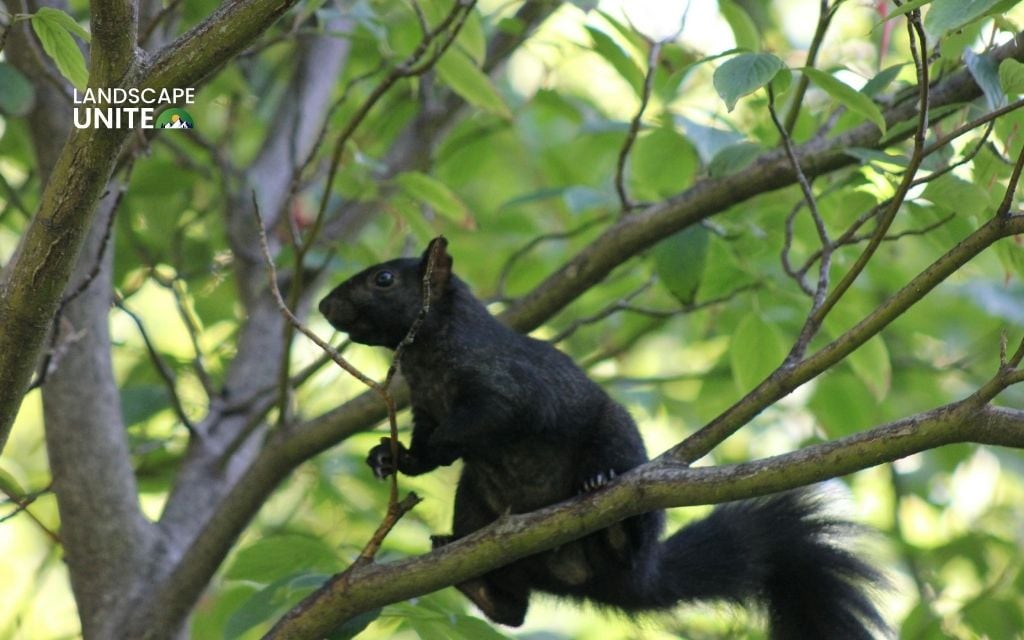
Accept reasonable coexistence
In suburban and urban settings, completely eliminating squirrels is neither possible nor desirable. Squirrels play important ecological roles in dispersing seeds and serving as prey for raptors. Aim to minimize garden damage to acceptable levels rather than pursuing zero-tolerance elimination.
Design for coexistence
Design for coexistence by creating spaces where squirrel activity is acceptable – a naturalized corner with native plants – while protecting primary growing areas with barriers and deterrents. This zoning approach acknowledges squirrels’ presence while protecting cultivated spaces.
Collaborate with neighbors
Squirrels have large territories that don’t respect property lines. Neighborhood-wide efforts to remove attractants and implement humane deterrents create broader pressure that benefits everyone and prevents neighbors from unintentionally drawing squirrels into your area.
Conclusion
Successfully keeping squirrels out of garden spaces requires 3 core principles: consistency, diversity of methods, and realistic expectations. Squirrels are intelligent problem-solvers, but they’ll shift their attention when faced with persistent obstacles and better alternatives.
Don’t expect overnight success. Give your chosen methods 2-3 weeks of consistent application before deciding effectiveness.
Most importantly, remain patient and persistent. Your garden represents months of effort – it’s worth protecting properly. With the right strategies and realistic expectations, you can outsmart even the most determined squirrels while respecting their place in the ecosystem.
Need more guides to protect your flower bed and garden? Check out our comprehensive gardening library on our website today!
Frequently asked questions (FAQs)
What is the best way to keep squirrels out of the garden?
The best way is to combine physical barriers, natural repellents, and squirrel-resistant plants. Hardware cloth fencing around vegetable gardens provides permanent protection, while cayenne pepper spray offers flexible coverage for flower beds. Squirrels adapt to single deterrents, so using multiple methods creates the most effective defense.
Do coffee grounds keep squirrels away?
Yes, squirrels dislike the strong aroma and gritty texture of coffee grounds. Sprinkle used grounds around flower beds and refresh weekly as the scent fades. They work best combined with other deterrents and provide the bonus of adding nitrogen to your soil as they decompose.
How do I stop squirrels from digging up my flower pots?
Cover soil with decorative stones or wire mesh cut to fit the pot opening. Apply cayenne pepper spray weekly to pot rims and soil surfaces. Elevating pots on smooth pedestals makes them harder for squirrels to access and climb.
What plants will squirrels avoid?
Daffodils, alliums, hyacinths, and fritillarias contain toxic compounds squirrels instinctively avoid. Lavender, mint, rosemary, and marigolds have strong scents or textures that deter them. Plant these as borders around vulnerable species for natural protection.
Will aluminum foil or netting help protect plants?
Yes. Aluminum foil creates reflective, noisy surfaces squirrels dislike. Bird netting or hardware cloth provides physical barriers while allowing light and water through. Secure all netting edges to ground level to prevent squirrels from finding gaps. Both methods work well over ripening fruits and emerging bulbs.
